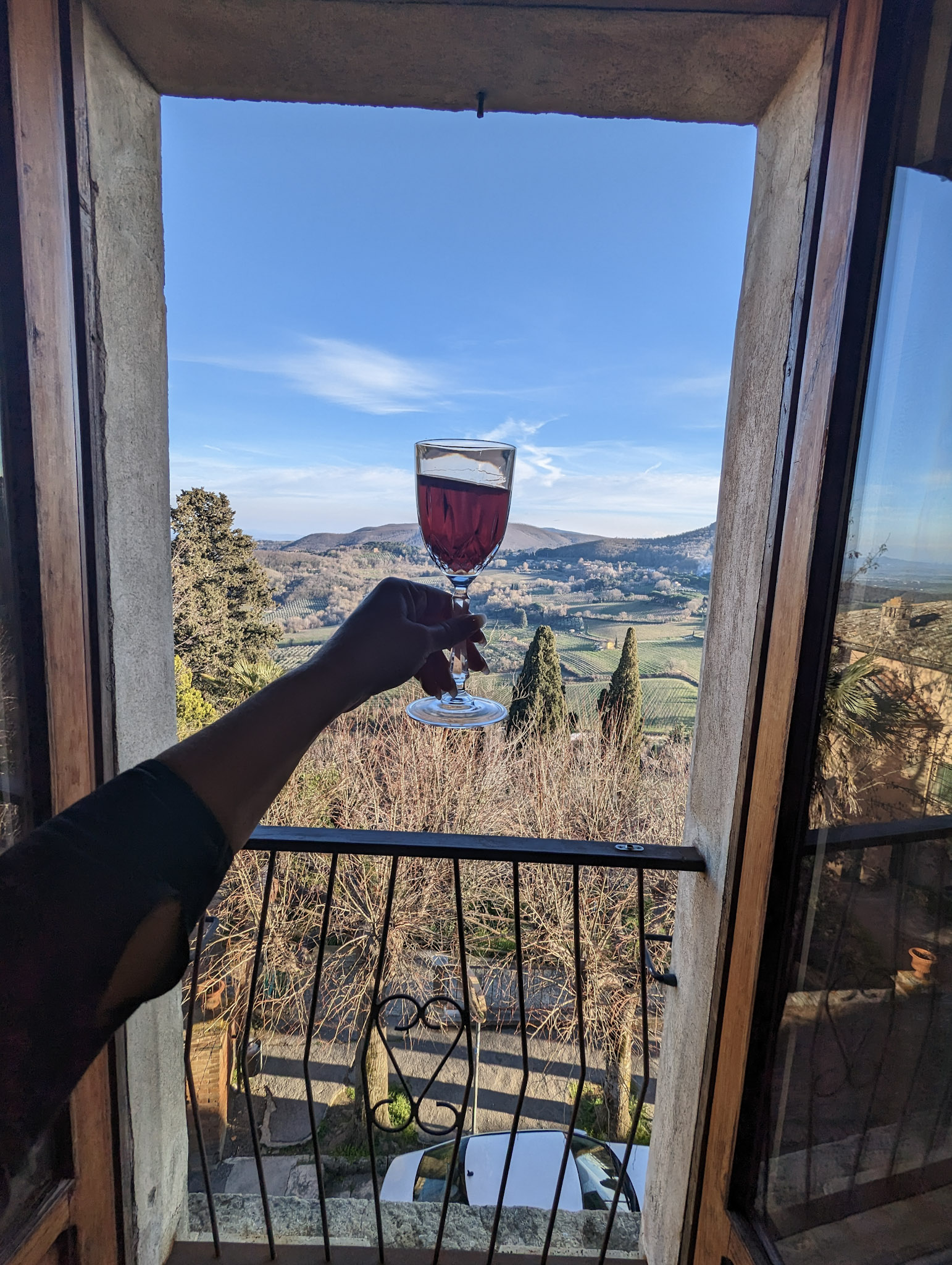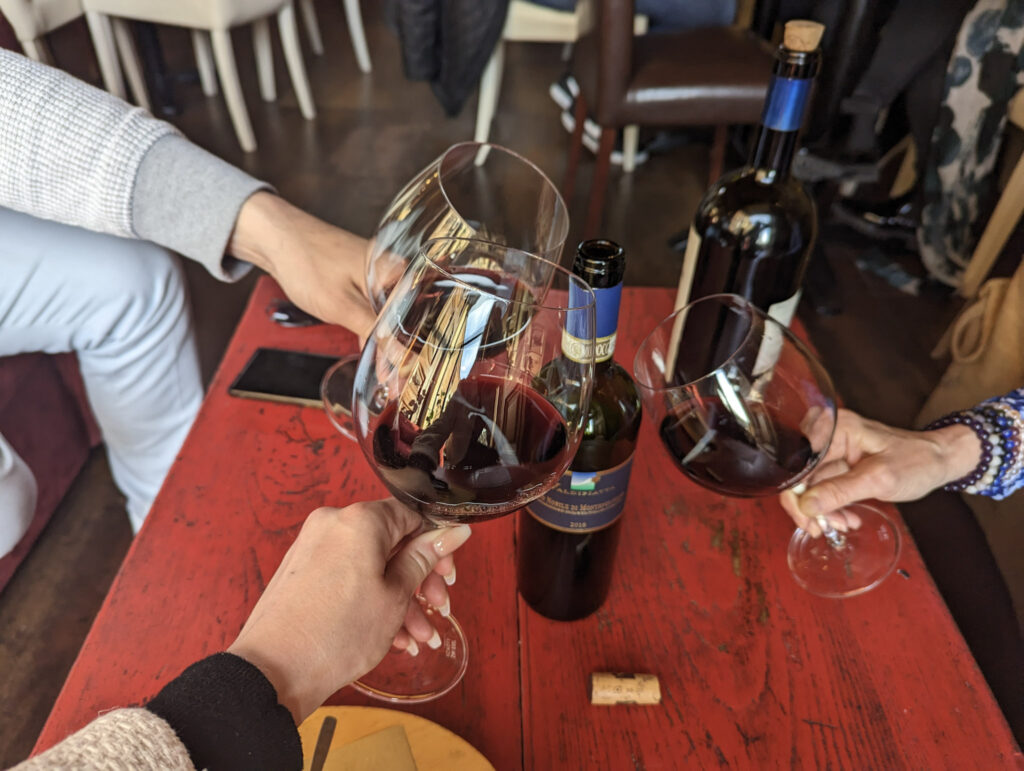
The Wines of Montepulciano & Montalcino: A Guide
So you’ve made the (wise) choice to learn more about the wines of Tuscany, and you’re ready to explore what Montepulciano and Montalcino have to offer.
Well let’s not waste any time in the intro – we’ve got vino to talk about!
Here is a crash course in the wine you’ll find in these two adorable Tuscan destinations.
Location
Montepulciano and Montalcino are neighboring towns located about a 40 min drive from each other in south Tuscany’s stunning Val d’Orcia. They are both medieval, small, and located on a hilltop (bring comfortable shoes and prepare your legs for a workout).


Wines of Montepulciano

Montepulciano – a Town and a Grape.
Let’s get this out of the way immediately – Montepulciano is both a town and a grape. And the town of Montepulciano does not use Montepulciano grapes to make its wine.
I know, this is confusing at first, but you’ll get it better once I explain:
Montepulciano, the grape, is grown throughout Italy and other parts of the world, and is the primary grape in multiple styles of wine – most notably the Montepulciano d’Abruzzo.
However, the Montepulciano that we’re talking about in this post is a town in Tuscany that makes its own wine. And, again, does not use any Montepulciano grapes in its wine.
This identical name drama consistently leads to confusion among consumers, as many assume that by ordering a Montepulciano wine on a menu means they are getting a wine from Montepulciano. But more often than not, they are getting the Montepulciano d’Abruzzo I mentioned before – a wine not produced in Montepulciano, but instead from the Abruzzo region located in central-east Italy.
So, moral of the story – Montepulciano on a bottle of wine or on a menu does not necessarily mean it is from Montepulciano. It could just contain the grape. Check with your server if you’re unsure, otherwise look for…
Vino Nobile di Montepulciano
Vino Nobile di Montepulciano (or simply, Nobile) is hands-down one of Tuscany’s top wines, and is the wine to know when visiting the town of Montepulciano.
Although today it is often overshadowed by other Tuscan powerhouses such as Chianti Classico or Brunello, back in ancient times, it was the wine of choice for visiting nobles. In fact, the wine’s name comes directly from this history (vino nobile means noble wine in Italian). It was even declared “the king of all wines” by poet Francesco Redi in 1685!
So what do you need to know about this oh, so important wine?
Well, to start, know that all Nobiles that make it for sale are DOCG classified – meaning the Italian government has guaranteed the production procedures and quality of each wine being bottled.
Also, Tuscany’s prized grape, the Sangiovese (known locally as “Prugnolo Gentile”), makes a heavy appearance, as Nobiles must be made up of at least 70% Sangiovese. The remaining 30% can be a variety of other complimentary grapes, though Caniolo, Mammolo, Merlot, and/or Cabernet Sauvignon tend to be the most frequently used. It’s also not uncommon for producers to forgo the blend entirely and make their wines 100% Sangiovese.
Vino Nobile di Montepulciano wines must be aged for a minimum of two years, and expect a beautiful, deep ruby colored wine to be poured when opening a bottle.
In terms of tasting notes, you’ll pick up on dark berries, juicy black cherry and a little earth. Its medium body, and dry, balanced taste makes it a perfect wine to pair with grilled or roasted meats, red sauces, and stews.
Other Wines of Montepulciano
Ok, so you know the biggie now, but what else can you expect to see that’s local on a wine list in town?
If you’re looking for a red that’s a little fresher and fruitier, definitely give the Rosso di Montepulciano a try. Made with very similar production as the Nobile (though it is a DOC, not DOCG), Rossos are also minimum 70% Sangiovese, but only require six months of aging. This is an excellent choice for aperitivo or first courses and pairs wonderfully with most pasta, pizza, and lighter dishes. Because it is younger, it will also be more affordable than a Vino Nobile di Montepulciano.
On the opposite end, if you’re in the mood for something a little richer, order a bottle of Vino Nobile Riserva. This is simply a Vino Nobile that has been aged longer (must be at least three years total), and is therefore bolder with notes of black pepper and spice. It’s the perfect accompaniment to heartier dishes such as wild boar.
And finally, for something totally different, there’s Vin Santo di Montepulciano. A sweet, white dessert wine, this one is often dark yellow in color and paired with, well, dessert. It does also work well as an aperitif though too.
Wines of Montalcino

Brunello di Montalcino
Anyone with a passing interest in fine wine has more than likely heard of Brunello. Short for Brunello di Montalcino, this wine is consistently considered some of the best in the world.
Alongside Barolo wine from Piedmont, Brunello was the first in Italy to earn DOCG status in 1980.
And, perhaps as no surprise, Sangiovese is also the grape of choice for this spectacular red. One of the key differences from Vino Nobile di Montepulciano, however, is that Brunellos must be 100% Sangiovese. This makes it a bit trickier to produce because you cannot blend in other grapes to alter the taste of the wine should you wish.
The word “Brunello” translates roughly to “little dark one”, and it is very likely that this name was given to differentiate itself from nearby Chianti. Expect a rich garnet color in your glass and a medium-to-full body. It pairs wonderfully with steaks, mushrooms, game, and heavier dishes in general. Sharp cheeses and stews also work very well.
Young vs. Old
All Brunellos require minimum of five years aging – though many will wait much longer than that before opening up their bottle.
Why?
Because the boldness of this wine – along with its high tannins and acidity – greatly extend its life and give it a whole new complexity when aged longer. Opening a Brunello that has been aged for 10+ years will taste softer and more elegant. The brighter fruit notes you taste in a younger Brunello will have transformed into more hazelnut and dried fig. The slightly tart sensation in your mouth with will no longer be there, and you’ll find the tannins almost chocolatey in older Brunellos.
Other Wines of Montalcino
Just like Montepulciano has a Rosso di Montepulciano, Montalcino has their Rosso di Montalcino, and its a great DOC option that’s younger (only one year aging required) and lighter. A perfect wine for earlier in the day, or when you don’t yet need something as full-bodied or pricey as a bottle of Brunello.
And, of course, there are vintages in Montalcino as well! The Brunello di Montalcino Riserva must be aged for at least six years, though many consider this a classic “cellar” wine and will let these bad boys age for much, much longer. These are very complex wines with plenty of body.
Sant’Antimo is an appellation in Montalcino that was designated as a DOC in 1996. These wines can be red, white or Vin Santo (dessert wine) and are typically not made with Sangiovese grapes, as those are often reserved for Brunellos or Rossos. Instead, expect blends consisting of grapes such as Cabernet Sauvignon, Merlot, Pinot Grigio or Chardonnay.
And finally, we have the Moscadello di Montalcino, a sweet, white wine made of 100% Moscadello grapes – a local form of the ancient Muscat grape (the same parent grape as Moscato). It comes in sparkling and still varieties.
In Conclusion
It’s hard to do wrong when breaking open a bottle produced in either Montepulciano or Montalcino. These towns take their wine seriously and the adherence to strict Italian DOC classification system ensure they are both constantly producing phenomenal vino.
And while it’s plenty fun to sample this stuff at home, there’s nothing quite like roaming the vineyards of Tuscany yourself, meeting with the winemakers behind some of these iconic wineries.
Interested in making that happen? Let JLJ Travel, a boutique travel design agency, craft a Tuscan getaway just for you! Click here to schedule a complimentary intro call.
April 15, 2023